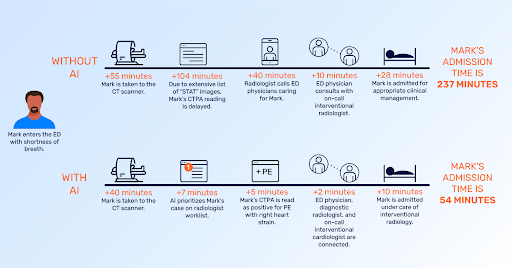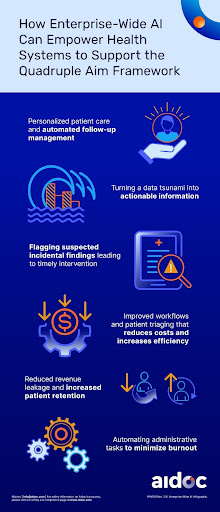Last Modified: July 18, 2024
The Role of Artificial Intelligence in Healthcare
Artificial intelligence (AI) is stealing headlines and rapidly transforming various industries, and healthcare is no exception. With its ability to process vast amounts of imaging data and to perform complex tasks, the role of AI in healthcare is continually reshaping, impacting the healthcare landscape in numerous ways.
Initially perceived as something that would render the radiologist irrelevant, health systems are learning that the combination of physicians and AI are finding ways to excel performance under unprecedented pressures, including but not limited to ever increasing imaging and patient volumes with a demand for high quality output.
In this blog post, we delve into the benefits of AI in healthcare, exploring how AI technology is revolutionizing patient care, improving health system efficiency and driving better patient outcomes.
1. Using AI for Better Patient Outcomes
One of the primary benefits of AI in healthcare is its capacity to help improve patient outcomes. Whether it’s associated with decreasing length of stay for intracranial hemorrhage and pulmonary embolism patients or, as the infographic below suggests, decreases time to admission, there’s a great advantage to AI in healthcare from the patient perspective. The infographic below illustrates a hypothetical patient workflow in a hospital using AI versus one without AI.
Want to learn more about how AI can improve patient outcomes? Download our free white paper below:
2. Improve Care Team Coordination
An added advantage to healthcare AI is its ability to capitalize on team-based workflows via clinical workflow optimization. Take the pulmonary embolism response team (PERT) at Yale New Haven Health, for example. By using Aidoc, a retrospective study found that the ability of AI to keep all pertinent information in one place streamlined communication between PERT members, including the transfer of images and clinical information.This culminated in:
- Faster and better patient treatment (e.g. administration of advanced therapies)
- Comprehensive notifications at Yale’s PERT center at time of diagnosis
- Increased collaboration between hub and spoke facilities
Listen to the full webinar here.
3. Reduce Staff Burnout
A notable healthcare pain point addressed by AI in healthcare is helping to reduce staff burnout. Month after month, staff burnout is cited as one of the top health system concerns as patient volumes grow and workforces shrink. In the spirit of doing more with less, one application of AI in healthcare is resource allocation, empowering doctors using AI to fight burnout. In other words, AI can appropriately triage resources to address emergent conditions at every patient touchpoint. If you only have one stone to throw, you better aim well. Click here to read out eBook Maximizing Patient Care with Limited Resources.
4. Achieve Quadruple Aim of Healthcare
The ability of AI to optimize health system performance in accordance with the quadruple aim is paramount. The quadruple aim of healthcare consists of::
- Enhancing the patient experience
- Improving population health
- Reducing costs, and
- Improving work life for care teams
Proper application of AI in healthcare helps health systems meet these goals through various means, such as personalizing patient care and automated follow-up management, turning data tsunamis into actionable information, improving workflows and patient triaging to reduce costs and increase efficiency and more.
What Is the Importance of Achieving the Quadruple Aim?
Achieving the quadruple aim of healthcare is crucial for health systems, as it provides a comprehensive framework for improving performance and, more importantly, patient outcomes. This holistic approach ensures that patients receive more effective and efficient treatments, leading to better health outcomes and higher satisfaction rates.
Moreover, the quadruple aim addresses the sustainability and efficiency of healthcare systems. By reducing costs through streamlined processes and focusing on preventive care, health systems can allocate resources more effectively. Additionally, improving the work life of healthcare providers can reduce burnout and turnover rates, leading to a more stable and motivated workforce.
5. Improved Patient Retention
While there may not be a direct cause-and-effect relationship between increased disease awareness- including incidental findings – and more hospital revenue, fewer missed patients in the ED and outpatient facilities means more patient admissions with DRG payment potential. At Aidoc partner facilities, our AI solutions have helped increase admissions, activate clinically relevant advanced interventions and retain patients with long-term surveillance and risk of interventions across multiple pathologies, including:
- Intracranial Hemorrhage: 12% increase at Unfallkrankenhaus Berlin (UKB)
- Pulmonary Embolism: 16% increase at Envision Healthcare
- C-Spine Fracture: 5% increase at Lahey Medical Center
Clinical AI enables hospitals to work smarter, not harder, with the resources available. By consolidating data from disparate places and turning this tsunami into actionable insights, care teams are able to utilize AI in healthcare to make better treatment decisions.
7. Reducing Length of Stay in Hospitals
AI in healthcare is crucial right now. Health systems that continue to rely on human-only decisions are falling behind. The AHA reported that delayed discharges led to a 19% increase in patient length of stay, and that’s with patient reductions in both the emergency department and the operating room. On the contrary, a Cedars-Sinai study found, after implementing an AI triaging software, that there was an 11.9% and 26.3% length of stay reduction for intracranial hemorrhage and pulmonary embolism patients, respectively. Reducing length of stay is important for a variety of reasons, including freeing up space for new patients and reducing the odds that patients will experience secondary health complications from a prolonged hospital stay.
8. Personalize Patient Care
A major pro of AI in patient care is its ability to facilitate personalized patient care. For AI to empower facilities to better personalize treatment paths, you must adopt an image- and report-based AI platform. By using natural language processing (NLP) combined with image-based AI algorithms, patients are more quickly routed to the relevant care teams for prompt decision-making through mobile and desktop applications.
9. A Profit Center for Health Systems
A common myth regarding clinical AI is that its financial benefits cannot be proven because there is no payor reimbursement. That is an oversimplified perspective. While there is currently no direct reimbursement for AI-assisted care, many business-critical technologies do not have a direct reimbursement mechanism yet hospitals are reimbursed from services that rely on these technologies. The value of AI is its intrinsic ROI. With enhanced disease awareness capabilities, improved care coordination and patient management tools, AI-assisted physicians and health systems can find new revenue streams through clinically-appropriate interventions, including incidental findings and patient retention.
Learn more about the ROI of AI through our in-depth eBook.
10. Maximizing Value
Each patient touchpoint presents an opportunity for health systems. Patient retention is now as important, if not more so, than patient acquisition. Whether in value-based or fee-for-service models, health systems using a connected system of intelligence can benefit from predictive and personalized treatment plans, enhancing disease awareness and resource efficiencies that support patient retention and maximizing patient care opportunities.
Enterprise-wide AI can help:
- Increase clinical efficiency to reduce costs and waste
- Uncover misdiagnosis or incidental findings, leading to timely interventions
- Manage patient surveillance and follow-up to support retention.
AI in Healthcare Examples
Now that you’ve seen the benefits of AI in healthcare, check out our blog post in which we explore some AI use cases. These include but are not limited to:
- AI for venous thromboembolism
- AI for aortic conditions
- AI for cardiology
- AI for bone fractures
- AI for neuro care










